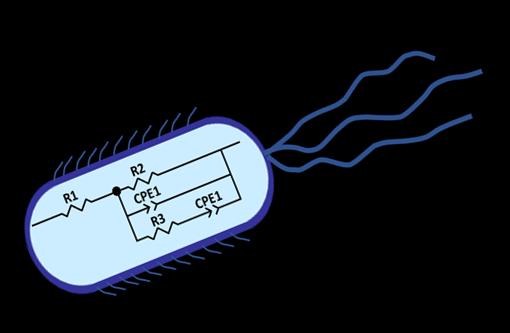SRNL demonstrates electrochemical techniques for monitoring microbial growth

Electrochemical techniques are being used to define microorganisms as electrochemical entities and thereby provide opportunities to monitor microbial activity in real time, in-situ. This approach is expected to decrease analytical costs while providing an abundance of data for industrial bioprocesses. Credit: Savannah River National Laboratory
Microorganisms are used in many industrial applications, including production of fuels, chemicals, pharmaceuticals, and foods (e.g., ethanol, acetate, biodegradable plastics, penicillin, and yogurt).
Like all organisms, microorganisms use food sources such as sugars, proteins, and lipids to obtain organic carbon for growth as well as energy from electrons released during break-down of food sources.
A decline in the vigor of a microbial culture could be caused by a diminishing food source, presence of a growth inhibitor, or contamination from another culture. To avoid further decline, any such issue needs to be addressed promptly.
To ensure the microbes are performing optimally, their cell numbers and / or chemical byproducts must be monitored. The conventional approach is to take periodic samples from microbial cultures to analyze the growth status of the cells.
Hands-on sampling and analysis are time consuming, labor intensive, and costly, which may allow problems to persist for hours before they are detected.
This Savannah River National Lab-led research team has demonstrated a multi-faceted, automated approach to monitor the energy levels of microbes.
One part of the technology provides an alert when cellular energy levels decrease. With electrodes poised at a specific reducing potential, microbes in the culture can pull energy into their cells in the form of electrons from the electrodes held adjacent to the culture.
The small portion of the culture that contacts the electrodes serves as an early warning system for sub-optimal conditions. The energy taken into the microbes from the electrodes shows up on a computer screen as an increase in electrical current.
Because this electrochemical activity can be monitored as it happens, this technique can be used to maintain the right conditions for optimal microbial behavior.
The other portion of the technology uses electrochemical impedance to monitor the culture throughout the growth cycle. In this way the microbial culture can be defined with an equivalent electrical circuit.
The equivalent circuit can then be used to fit impedance data and provide valuable information about the culture that relates to the physiological status of the culture. This approach offers significant potential for decreasing analytical costs as well as automating bioprocesses.
###
This research was supported by Bioenergy Technologies Office, Office of Energy Efficiency & Renewable Energy, U.S. Department of Energy. Authors of the paper are: Ariane L. Martin, Pongsarun Satjaritanun, Sirivatch Shimpalee, Blake A. Devivo, John Weidner, Scott Greenway, J. Michael Henson and Charles E. Turick.
The U.S. Department of Energy's Savannah River National Laboratory is a multidiscipline research and development center, where accomplished scientists and engineers solve the Nation's most challenging environmental and security problems. Working with partners, the laboratory protects the Nation by applying science to global security, the environment and the energy economy. Savannah River National Laboratory is managed for DOE's Office of Environmental Management by Savannah River Nuclear Solutions, a Fluor-led company whose members are Fluor Federal Services, Newport News Nuclear and Honeywell.
Links:
Media Contact
More Information:
http://dx.doi.org/10.1186/s13568-018-0692-2All latest news from the category: Life Sciences and Chemistry
Articles and reports from the Life Sciences and chemistry area deal with applied and basic research into modern biology, chemistry and human medicine.
Valuable information can be found on a range of life sciences fields including bacteriology, biochemistry, bionics, bioinformatics, biophysics, biotechnology, genetics, geobotany, human biology, marine biology, microbiology, molecular biology, cellular biology, zoology, bioinorganic chemistry, microchemistry and environmental chemistry.
Newest articles

High-energy-density aqueous battery based on halogen multi-electron transfer
Traditional non-aqueous lithium-ion batteries have a high energy density, but their safety is compromised due to the flammable organic electrolytes they utilize. Aqueous batteries use water as the solvent for…

First-ever combined heart pump and pig kidney transplant
…gives new hope to patient with terminal illness. Surgeons at NYU Langone Health performed the first-ever combined mechanical heart pump and gene-edited pig kidney transplant surgery in a 54-year-old woman…

Biophysics: Testing how well biomarkers work
LMU researchers have developed a method to determine how reliably target proteins can be labeled using super-resolution fluorescence microscopy. Modern microscopy techniques make it possible to examine the inner workings…





















